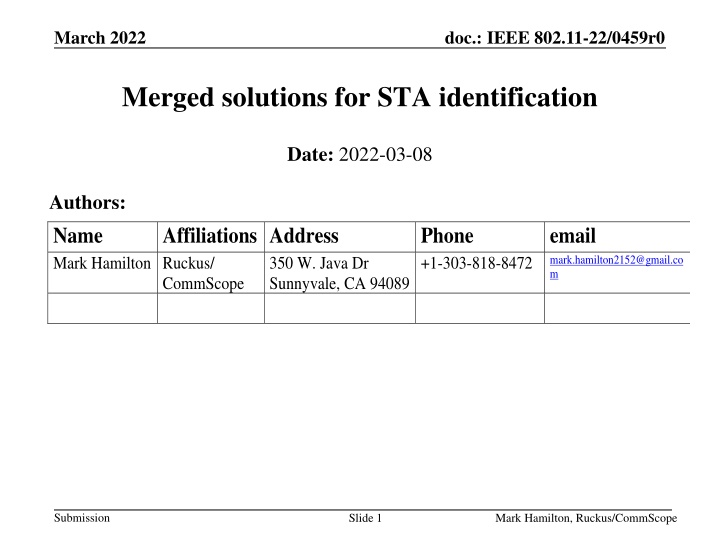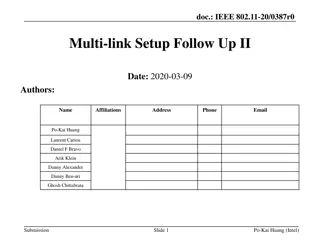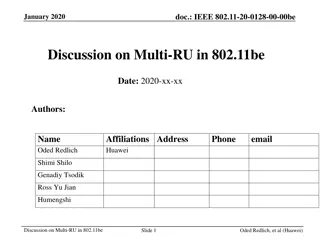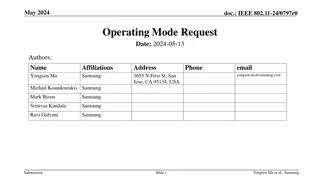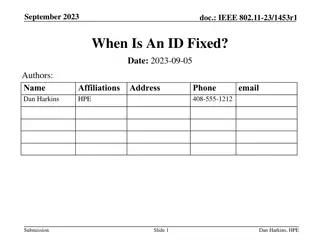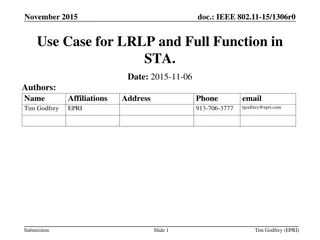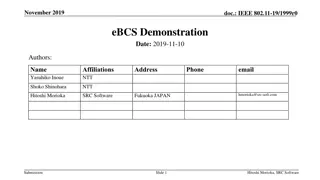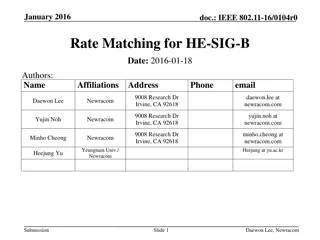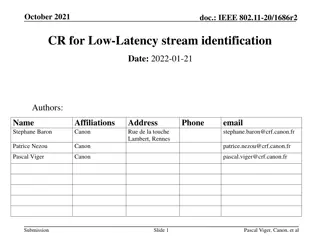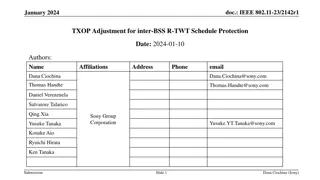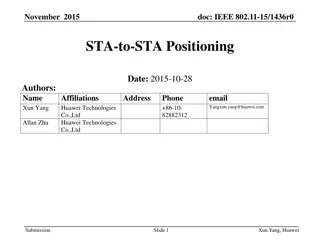Merged Solutions for STA Identification in IEEE 802.11-22
This document presents a proposal to merge various methods of STA identification, including network-generated ID, STA-generated ID, MAAD, and Unique Device ID, in IEEE 802.11-22. The background of the proposals, examples of ID flows, and the principles of merging these methods are detailed with support for flexibility and negotiation of styles. The submission slides by Mark Hamilton from Ruckus/CommScope provide insights into the merging process and its benefits for deployment scenarios.
Download Presentation

Please find below an Image/Link to download the presentation.
The content on the website is provided AS IS for your information and personal use only. It may not be sold, licensed, or shared on other websites without obtaining consent from the author.If you encounter any issues during the download, it is possible that the publisher has removed the file from their server.
You are allowed to download the files provided on this website for personal or commercial use, subject to the condition that they are used lawfully. All files are the property of their respective owners.
The content on the website is provided AS IS for your information and personal use only. It may not be sold, licensed, or shared on other websites without obtaining consent from the author.
E N D
Presentation Transcript
March 2022 doc.: IEEE 802.11-22/0459r0 Merged solutions for STA identification Date: 2022-03-08 Authors: Name Mark Hamilton Ruckus/ Affiliations Address Phone +1-303-818-8472 email mark.hamilton2152@gmail.co m 350 W. Java Dr Sunnyvale, CA 94089 CommScope Submission Slide 1 Mark Hamilton, Ruckus/CommScope
March 2022 doc.: IEEE 802.11-22/0459r0 Abstract Proposal to merge network-generated-id, sta-generated- id, MAAD, and Unique device ID Submission Slide 2 Mark Hamilton, Ruckus/CommScope
March 2022 doc.: IEEE 802.11-22/0459r0 Background All three proposals have very similar principles Merge them, allow for negotiation of style Supports many use cases, provides flexibility for deployment model to fit the scenario Note: Opaque device ID can also be used as method for Blobs in network-generated usage Submission Slide 3 Mark Hamilton, Ruckus/CommScope
March 2022 doc.: IEEE 802.11-22/0459r0 STA AP { Blob | ID } Msg 2/4 { OK | Blob } [MAAD] Msg 3/4 OK Msg 4/4 Submission Slide 4 Mark Hamilton, Ruckus/CommScope
March 2022 doc.: IEEE 802.11-22/0459r0 Example flow Network generated ID New STA: STA provides nothing in Msg 2/4 (maybe we add an indication of intent to use network generated ID?) Network generates a Blob Network responds with Blob in Msg 3/4 (Maybe add an OK acknowledgement in Msg 4/4?) Returning STA: STA provides Blob in Msg 2/4, (encrypted in Key Data) Network is configured for network ID, so expects the Blob Network confirms it recognizes the Blob Network responds with OK in Msg 3/4, or optionally provides an updated Blob Submission Slide 5 Mark Hamilton, Ruckus/CommScope
March 2022 doc.: IEEE 802.11-22/0459r0 Example flow STA generated ID New STA or returning STA (same flow for both): STA provides ID in Msg 2/4, (encrypted in Key Data) Network is configured for STA ID, so doesn t expect a Blob Network responds with OK in Msg 3/4 Submission Slide 6 Mark Hamilton, Ruckus/CommScope
March 2022 doc.: IEEE 802.11-22/0459r0 Example flow Optional MAAD For either network-based or STA-based: Initial connection: STA uses random MAC address to connect Network provides MAAD address in Msg 3/4 (Maybe add an OK acknowledgement in Msg 4/4?) STA continues with random MAC address during association Returning station: STA uses new MAAD address (provided last time) to connect Network provides new MAAD address in Msg 3/4 (Maybe add an OK acknowledgement in Msg 4/4?) STA continues with last time MAAD address during association Submission Slide 7 Mark Hamilton, Ruckus/CommScope
